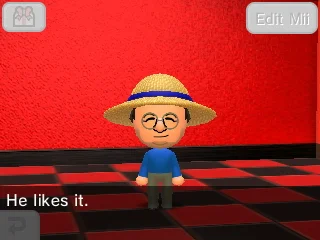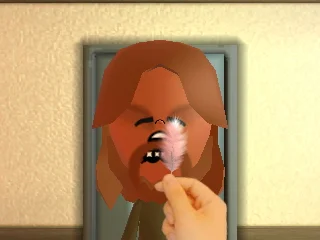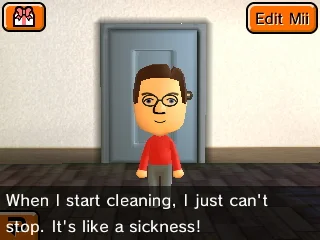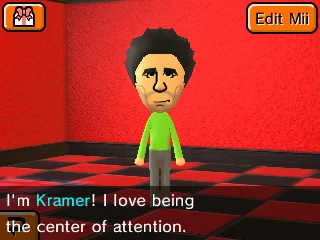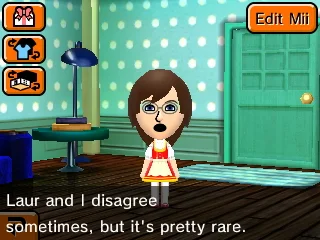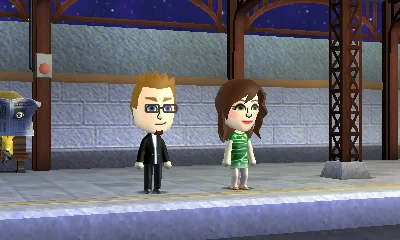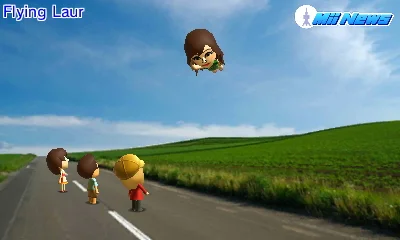If you've read or watched anything about Tomodachi Life so far, you'll know that it doesn't fit the traditional definition of a video game. It doesn't let you control a character, it doesn't involve combat of any kind, there are no levels, you don't win or lose, and there aren't even any pre-defined characters or a story.
So what, exactly, is it?
Much like the old (and similarly-named) Tomagatchi digital pets of the late 1990s, Tomodachi Life centers around observation—only, here, you're not watching a pixelated creature, you're viewing an island of Mii characters that you create and choose. It's far more compelling, and, while you do have to feed them occasionally, there are no droppings to clean up (a step in the right direction, for sure). This is the perfect game to download on your Nintendo 3DS for quick, on-the-go sessions, giving you a unique world to check in on each day.
George Costanza asked for a hat. I was honestly a little surprised that he liked it.
Chewbacca needed me to get a feather off of his head. Because that's a real Wookie problem.
The game starts by asking you to create (or import) your "look-a-like" Mii; but, from there, you're free to populate an apartment complex with any Miis you might want. Friends, family members, celebrities, even fictional TV show characters. Let's just say that I definitely have the cast of Seinfeld living on my island.
Once imported, you get to define their characters that will influence how they interact and live on your island. While this is merely a set of sliders, I was impressed by how accurately it captured the personalities that inspired my island's inhabitants. Here are a few examples:
Ask my wife--I really prefer that she plan these things.
My dad really does like to clean this much.
Obviously.
My mom does, indeed, get along with my wife!
Much like Nintendo's other 3DS "life sim," Animal Crossing, this is a game best experienced in short, daily play sessions. However, despite some surface-level similarities, they really are quite different games. While Animal Crossing puts you in the shoes of a villager and focuses on building out a town, decorating your house, and navigating the local politics of small town life, Tomodachi Life breaks the fourth wall and acknowledges you the player, peering into this world through you 3DS' screen. You are not a direct part of this world, but you'll want to drop in on your islanders to see what they're up to, what they might want (yes, they get hungry), whom they have a crush on, play little micro-games with them (think WarioWare), or just listen to what they might have to say.
And they really will say things because every character is fully voiced.
Yes, you read that right. Nintendo games have never been known to feature much voice work (Metroid Other M notwithstanding), so this news might come as a bit of a surprise. Before you get too worked up, though, we're not talking about actual voice actors here; rather, the developers smartly leveraged text-to-voice functionality (a la Siri) to give each Mii its own pair of digital lungs.
For each character you create, you can customize the tone, accent, speed, pitch, etc., to get a good range of vocal options. The results are mixed with some natural speech patterns recreated accurately, but others can sound overly-digitized with strange squeaks or squelches on certain words or syllables. I would have liked even more options to get a wider palette of voices, but the fact that the characters all speak is a huge part of why this game is fun.
Oh, did I mention that yet? Yeah, the game (or whatever you want to call it) is quite fun.
I mentioned earlier that this is a game about observation, and that might sound really dry and boring. Thankfully, this experience revels in the completely absurd: characters say and do off-the-wall things regularly, and the fact that you're watching little versions of the people that make up your world (real or fantasy) make it (almost) endlessly entertaining.
Allow me to share some encounters I've had so far:
- I got some toilet paper, which apparently qualifies as a "treasure"
- My mom tried to set me up on a date with my wife and then followed us around to spy on us
- C-3PO and Chewbacca became friends
- I made Kramer from Seinfeld live in a hamster cage
- George Costanza delivered a special news report about a flying Mii of my wife
The brilliance of the game is really centered on the often-hilarious antics of your Miis, but that's also the game's biggest drawback: it's only as good as what you're willing to put into it. The game unlocks most of the island's content over the first few weeks of playing, but it requires you to create or import Mii characters (you can create and share QR codes to make this easier, though), and then interact with them. The game really relies on you populating your island with characters that you will find funny when they do strange and unexpected things.
The fun here comes organically throughout in small doses and strange details, which is markedly different than the in-your-face fun in many AAA blockbuster titles. If you don't find the idea of watching the people in outrageous situations very amusing, then you've probably already figured out that this is not the title for you. But, if you're willing to invest in the experience, then you'll be rewarded with one of Nintendo's most bizarre and charming creations to date.
It should be noted that I have often argued that a strong narrative is one of the most important aspects of a game, but I don't miss it in Tomodachi Life. The narrative, if it exists at all, is one you make for yourself as you mix and match personalities and watch their lives play out like some kind of god sim meets science experiment. You don't have to worry about expanding infrastructure or maintaining the island—the game simply ignores any of these typical sim tropes and lets you focus on the "human" interactions.
The small and strange encounters I've had in the game are easily the best use of Mii characters since their introduction on the Nintendo Wii back in 2006. I had always hoped that the Miis would end up getting a more dedicated experience at some point. The Wara Wara Plaza on the Wii U's home menu was a glimpse into a world teeming with Miis, but it's more of a social network visualization. It may have taken Nintendo eight years to figure out exactly what to do with their adorable avatars beyond putting yourself in sports mini-games and extra Mario Kart characters, but they've finally found their home.
I recommend you pay them a visit.


